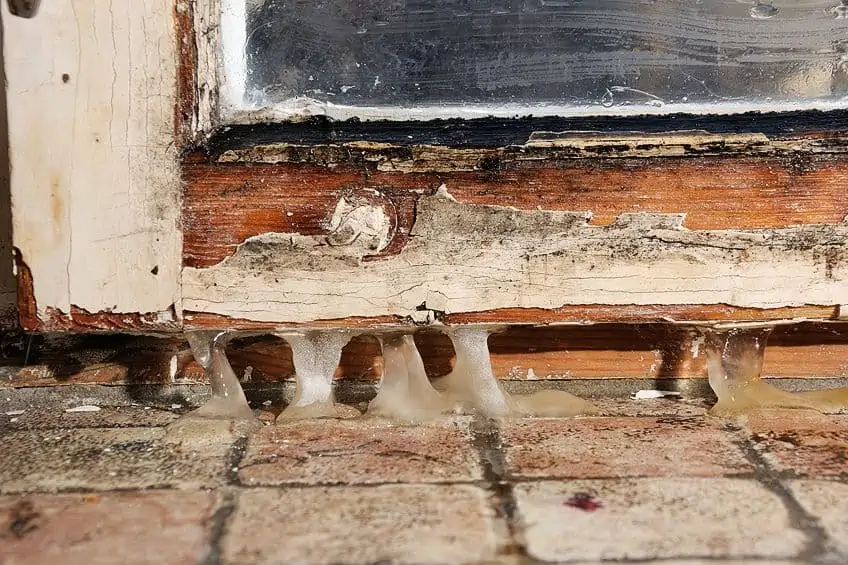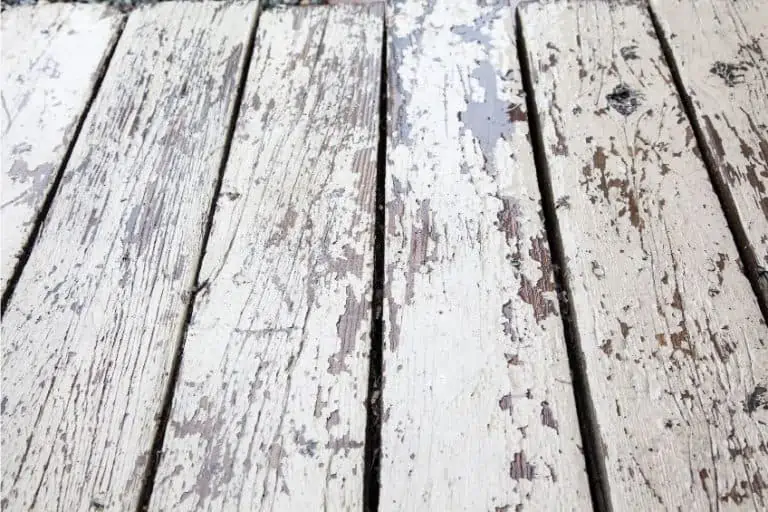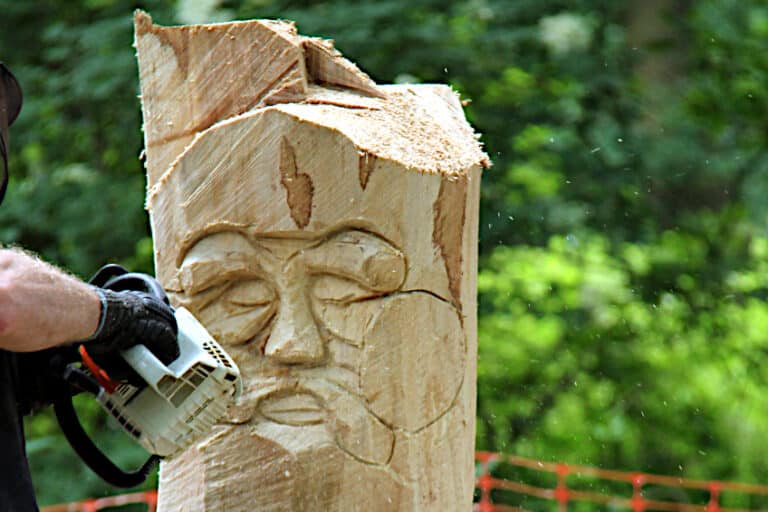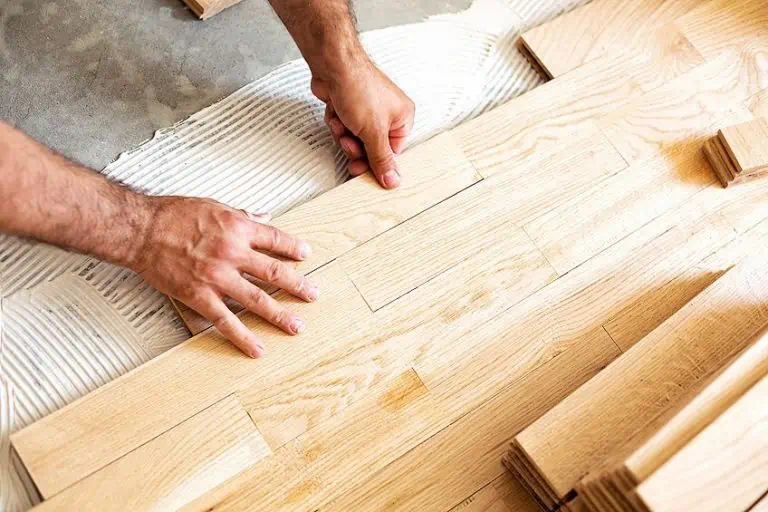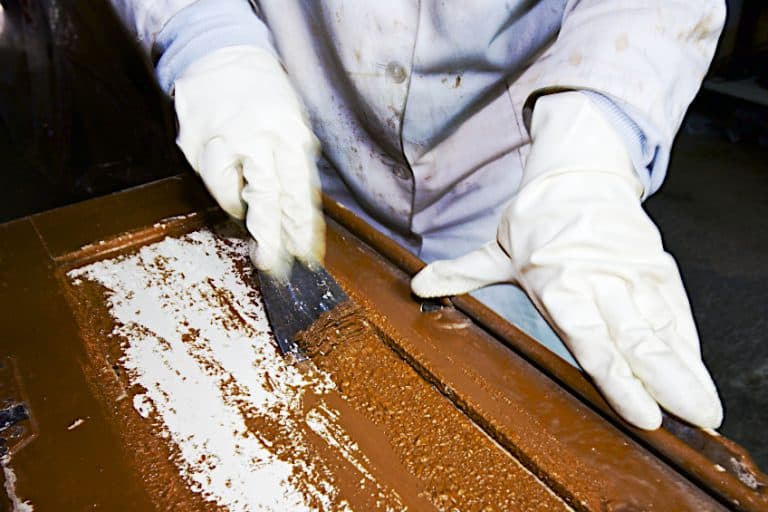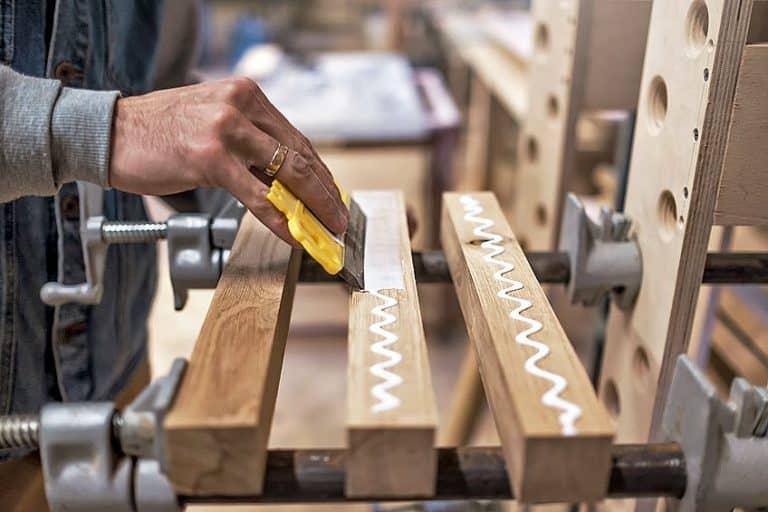How to Remove Mold from Wood – A Guide on Killing Mold on Wood
A patch or two of mold in the back of your closet may look harmless. Out of sight, out of mind, right? Household mold can not only ruin the surface of your wooden furniture and walls but can also negatively affect human health. Removing the appearance of mold from walls and furniture is one thing, but killing mold on wood and preventing its return is what is needed for peace of mind. This article aims to help you better understand mold as well as to help you remove mold from wood yourself.
Table of Contents
- 1 What Is Mold?
- 2 Mold, Fungal Spores, and Health
- 3 Wood Damage and Mold
- 4 How to Remove Mold from Wood Yourself
- 5 Professional Mold Removal
- 6 Tips and Tricks for Mold Prevention
- 7 Frequently Asked Questions
What Is Mold?
Mold is a type of fungi. There are thousands of varieties and they come in many colors and textures. Their primary function in nature is to help break down natural materials. If it were not for mold and other fungi, natural waste would pile high in forests as well as our landfills. Mold thrives in damp, dark areas. Its roots, also called mycelium, anchor the mold and draw out nutrients from its host. We need molds, but we do not want mold in our homes as they cause bad odors, poor air quality, and can ruin the finish on wood surfaces. This is why it is important to remove mold from wood before it spreads.
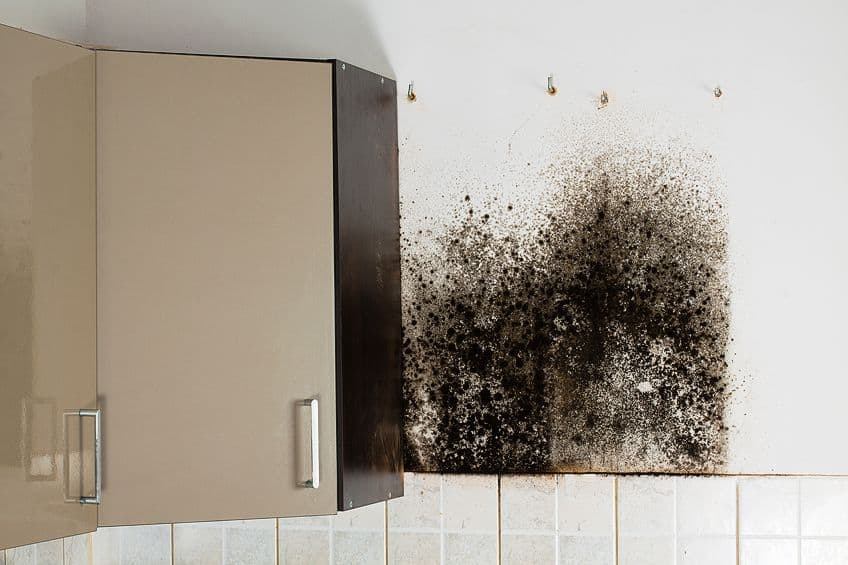
Types of Household Molds
There are thousands of different mold species. Some molds are toxic, but some, through science and research, have helped save lives. It is very difficult to positively identify mold. It is for this reason, therefore, that one must be very careful when dealing with household mold.
Green Mold
A variety of molds fall under the name green mold. It is commonly found on food that is decomposing like bread or fruit and it usually has a fuzzy texture. It is not as dangerous as white or black mold, but it is best to remove it from your home before it spreads. Some green molds may have antibacterial properties, but their spores can also contain toxins.
White Mold
White mold refers to a variety of dusty string-like molds. White mold can pose a threat to your health and it can also destroy wooden furniture or walls if it is not dealt with before it spreads. White mold can change color over time. It can grow on carpets, fabrics, plants, and like other molds, it grows well on damp surfaces.
Black Mold
Many molds are black, but Stachybotrys chartarum is often referred to as black mold. While all molds are potentially dangerous to your health, black mold is one of the most threatening and needs to be dealt with swiftly if found in your home. Black mold can be more difficult to remove than other molds as black mold tends to root itself more deeply into the wood.
Mildew
Mildew is often used as a blanket term for mold, but it can be better described as a type of mold. It is far easier to clean as it does not penetrate the surface of the wood like black mold does. While mold is usually slimy or fuzzy, mildew has a flat growth and is usually grey to white, sometimes turning brown over time.
Mold, Fungal Spores, and Health
Fungal spores are particles that enable fungi to reproduce. In essence, they are the seeds of fungi. As mold matures, spores can become airborne. These spores can be toxic especially to those who have a weak immune system, such as people who suffer from allergies or asthma. Even if you do not suffer from any existing respiratory issues, mold spores can still irritate your nose, throat, or lungs. It can also cause eye and skin irritation.
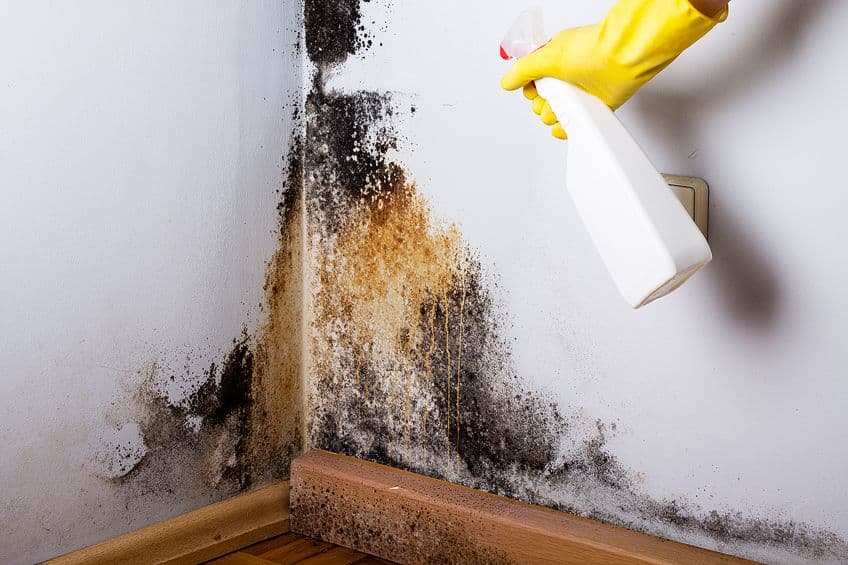
MOLD INSPECTION NETWORK DIY Mold Testing Kit
Considering the health concerns around mold, you may want peace of mind that you and your family are safe from the presence of toxic mold in your home. This test kit is a DIY alternative to hiring a professional mold inspector. You can use this kit to save money whilst receiving a detailed lab report and expert consultation on what your results mean.
- Easy, safe, and simple to use (quick start guide and full booklet included)
- Lab fees and detailed report included in price (except in Texas)
- Expert consultation to explain results and discuss inspection included
PROS
- Includes three surface strips
- Safe and easy to use
- Full report and lab fees included in the price
- Expert consultation included
CONS
- Limited post-test support
- Does not remove mold
Wood Damage and Mold
Mold tends to discolor the surface of the wood and sometimes it can cause discoloration deep into the surface. Molds alone do not necessarily cause wood to rot, but the same damp and dark conditions in which molds grow well are the same conditions that decaying fungi thrive in. These decaying fungi can cause structural damage that can lead to the collapse of part of or even an entire building if left unchecked.
This is why it is important to remove mold from wood before it spreads. One can look at mold as an early warning sign that your environment is ideal for other decaying fungi to develop and destroy.
Mold Enabling Environments
Mold will grow in places where there is excess moisture, such as near leaking pipes, roofs, or floorboards. Mold can thrive on virtually any surface as long as it is damp, but it grows especially well on porous surfaces like paper, cardboard, or wood.
Poor ventilation also contributes to mold growth, as this prevents the evaporation of moisture. High humidity is the main factor that accelerates the growth of mold. It is important to learn to control the humidity in one’s home, especially if you have existing mold problems. Read the tips and tricks section in this article to learn how to monitor and control the humidity in your home.
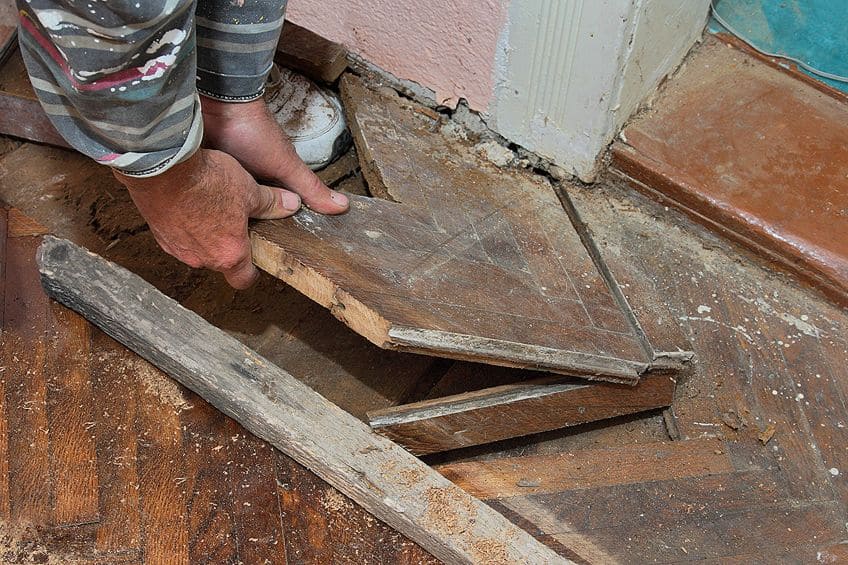
How to Remove Mold from Wood Yourself
There are several ways to remove mold from wood. The method you choose to use depends on the severity of the mold infestation. Unsealed and untreated wood might require scrubbing as well as sanding, as it can be quite porous. However, if the mold has not yet penetrated the surface, you may be able to remove the mold with a spray bottle and some white vinegar. Read on to find out how to clean mold from wood effectively using natural chemicals.
Safety First
Before getting started, be sure to use a respirator or an N95 or N100 mask to prevent spore inhalation. To avoid eye and skin irritation, it is advised that you use safety goggles and rubber gloves. Full-coverage clothing or coveralls are also advised, especially if you are sensitive to mold.
If possible, remove the infested item from the home. This will prevent the spread of the spores while you are cleaning the mold from the wood. Wrapping the infested item in garbage bags before moving it outside will prevent spores from being disturbed and dropped throughout your home. Killing mold on wood should be done in a well-ventilated area, which is why it is recommended to remove mold from wood while outdoors. If the mold is in a cupboard or ceiling, it is best to open all the doors and windows to maximize ventilation.
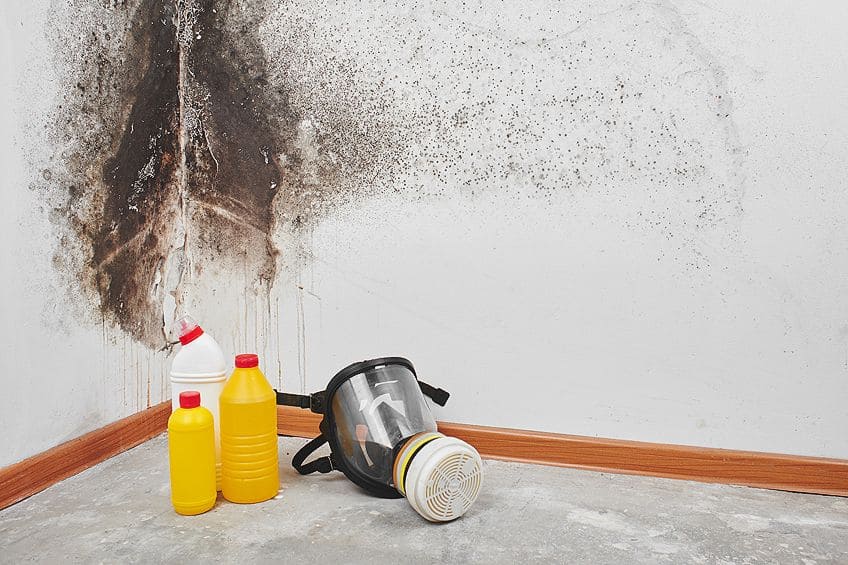
Vacuuming
Before attempting any of the cleaning methods below, vacuum the moldy areas of wood. This will remove bits of debris as well as some of the spores. Using a water vacuum or a HEPA vacuum is wise as it will prevent the spores from ending up back in the air. Dispose of the contents of the vacuum cleaner outdoors to avoid reinfecting your homes with spores.
Sanding / Planing the Wood
Untreated and unsealed wood is very porous and provides the perfect environment for mold to thrive, especially when damp. You might be asking how to remove black mold from wood, as black mold can root itself deep into the surface, and it can be difficult to remove by scrubbing with household chemicals. When all else fails, we can resort to sanding in order to remove mold from wood.
Use 100-grit sandpaper on the affected area of the wood, being careful not to dig too deeply into moldy areas. Using a sanding block or electric sander can help maintain an even surface. After removing the mold using sandpaper, one should let the wood dry out before sealing the wood with paint or varnish. Sealing the wood properly will prevent the mold from coming back.
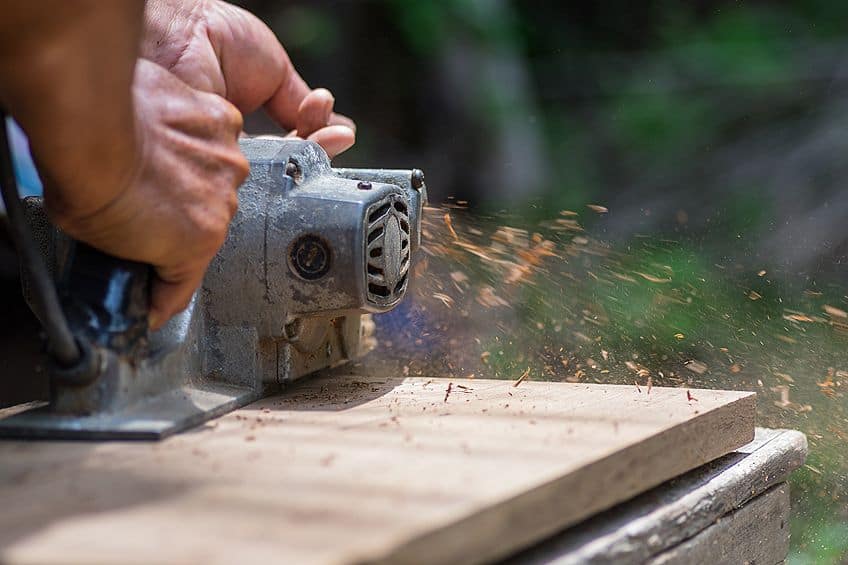
DIY Solutions for Removing Mold from Wood
It is important to note that the following methods are for DIY mold removal. If the surface area of the mold in your home covers more than 10 square feet, it is advised that you call a professional to remove the mold. It is best to catch mold in its earliest stages to prevent other decaying fungi from developing, which can do irreparable damage to your furniture or the structure of your home.
Vinegar, Vodka, and Sunlight
An example of light mold would be a small area of white surface mold or mildew on a painted item of furniture. A great way to remove this is to place the piece of furniture in the morning sunlight. Besides killing mold on wood, it will also remove bad odors.
White vinegar is a mild natural acid that can kill more than 80% of molds, and best of all, it is non-toxic. White vinegar is widely available and it is inexpensive. Spraying white vinegar on a surface and leaving it to dry can prevent mold from growing on it, though you may have to repeat this process frequently for it to be effective.
To accelerate the sunlight method, you can use equal parts water and white vinegar and apply it lightly to the infested areas with a spray bottle. Allowing the item of furniture to air dry and bringing it back inside before sunset is important. If needed, this process can be repeated the next day. Cheap vodka can also be used instead of white vinegar, as alcohol can be effective in killing mold on wood.
Scrubbing Heavy Mold
If the mold has penetrated the wood, you may need to scrub the surface using a soft bristle brush or a sponge. This can loosen the mold from the surface. Laundry detergent, water, and white vinegar can make a great mold remover for wood. Mix laundry detergent or dish detergent with warm water and white vinegar in a bucket. Apply the solution to the surface of the wood using a sponge or soft bristle brush, scrubbing the area and rising before wiping it clean with a clean cloth or towel. This process may need to be repeated to remove all the mold.
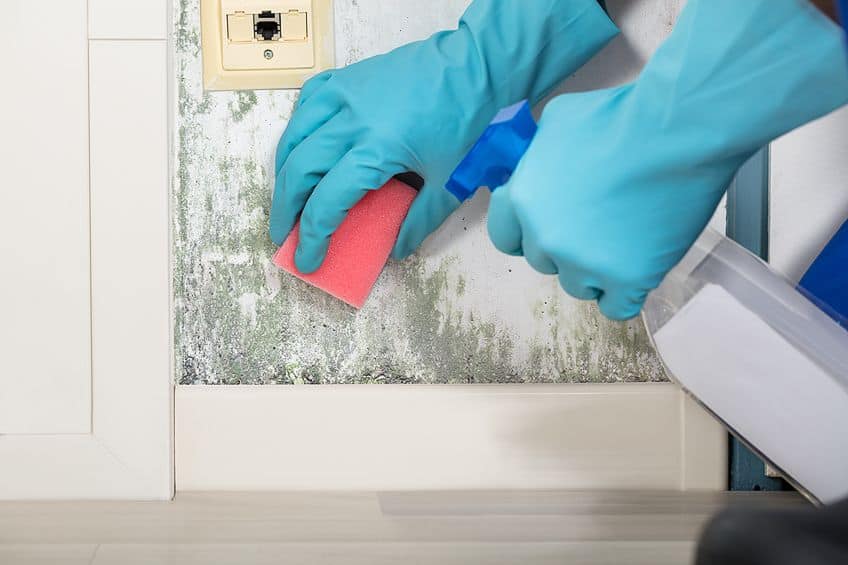
Borax
Borax is a natural fungicide. It is toxic if consumed but does not emit any noxious fumes when mixed with water. Add 8 ounces of borax to one gallon of water and mix. Apply the solution with a sponge or soft-bristled brush and leave it to dry. The borax that has dried on the surface can prevent the return of the mold as well as remove any odors. Borax can be bought at most supermarkets.
Tea Tree Oil
Tea tree oil is the most effective mold remover for wood as it has strong antifungal properties and kills all types of mold. However, it can be expensive. Mix one teaspoon to one cup of water. Use a spray bottle to apply the solution to the affected area and leave it to dry. Alternatively, mix the solution in a small bucket and use a sponge or brush to apply the solution. Wipe away the mold and solution with a clean cloth and allow to dry without rinsing. This will prevent the mold from returning for some time.
Grapefruit Seed Extract
Just like tea tree oil, grapefruit extract has effective antibacterial and antifungal properties. It is the citric acid in the extract that kills the fungi and prevents them from returning. Mix a solution by adding 10 drops of extract to one cup of water. As you would with tea tree oil, apply the solution to the affected area and allow it to dry.
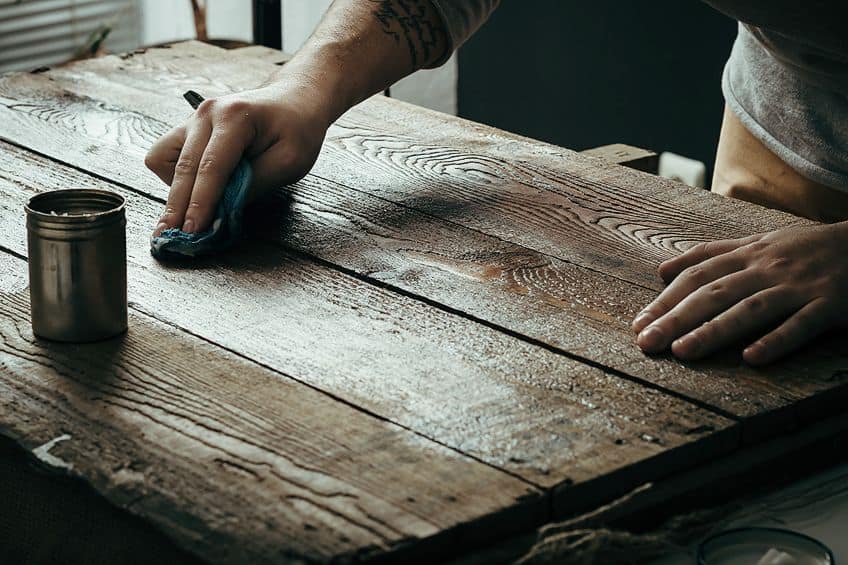
Store-Bought Products
There are a variety of mold remover for wood products on the market, as well as products that can be used to prevent any further mold from destroying your wood.
Best Product for Removing Mold: CONCROBIUM Mold Control Spray
A great alternative to mixing home mold remedies is Concrobium’s mold control spray. It is designed specifically for killing and preventing mold and mildew on surfaces. It comes premixed in a convenient trigger spray bottle that can cover up to 100 square feet.
- Use to eliminate mold, mildew, musty odors, and prevent regrowth
- EPA-registered formula crushes mold spores as it dries
- Unique mold spray is safe to use with no bleach or harsh chemicals
PROS
- Non-toxic
- Kills mold and prevents regrowth
- Ideal for use on drywall and wood
- No scrubbing or rinsing required
- No mixing required
- Odorless
CONS
- More expensive than white vinegar
- Will not kill mold that is deeply embedded in wood
Best Product for Preventing Mold: ECO ADVANCE Wood Siloxane Waterproofer
Exterior woods like decking or wooden fencing will benefit from a wood waterproofer such as Eco Advance’s wood siloxane. It can be used on new wood and refurbished wood. Not only does it protect the wood from oil stains and cleaning chemicals, but it also protects against mold and mildew.
- Protects against water damage, oils, stains, mold, salts, and chemicals
- Water-based, non-toxic, non-flammable formula does not harm landscape
- Vapor-permeable (breathable) water proofer can be used on new wood
PROS
- Non-toxic
- Water-based
- Will not harm plants
- No noxious vapors
- Protects exterior wood from mold and mildew
CONS
- Requires garden pump sprayer for application
- Does remove existing mold
Professional Mold Removal
If you are experiencing large areas of persistent mold developing in your home, it is recommended that you call a professional to remove the mold. Mold removal experts are trained professionals and use mold remediation equipment such as air scrubbers and dehumidifiers. To avoid disappointment, shop around. Beware of so-called professionals that come at an unbelievably cheap price, as their work may not be guaranteed.
Look for professionals in your area, ask for testimonials, and search for reviews by past customers.
Tips and Tricks for Mold Prevention
It is impossible to keep mold spores out of your home permanently. The best way to combat mold development is to control the environment. By reducing humidity and unwanted moisture in the air and surfaces, one can reduce the chances of mold developing. Below are tips and tricks to help you gain more control over the moisture in your environment.
- A dehumidifier can reduce moisture in the air and, as a result, starve the mold of the moisture it needs to grow.
- Allowing air to circulate through the home can help reduce the moisture in the air. Keeping a few windows open when possible will do the trick.
- Extractor fans in bathrooms can remove the excess moisture in the air. Cooking also produces a lot of humidity, and an extractor fan in the kitchen can combat this.
- Wait until the fabric is completely dry before storing freshly cleaned laundry. This will reduce the chance of mildew developing.
- Try to dry your laundry outside where possible, as drying laundry inside contributes to the humidity level.
- Fixing leaking pipes, roofs, and windows as soon as possible can prevent major mold problems. Neglect, over time, can cause irreparable damage.
- Properly installed insulation in walls and flooring can prevent condensation, which will lead to the dampness that mold thrives in.
- A hygrometer is a cheap measuring instrument for measuring humidity. The ideal humidity level to prevent mold is below 60%
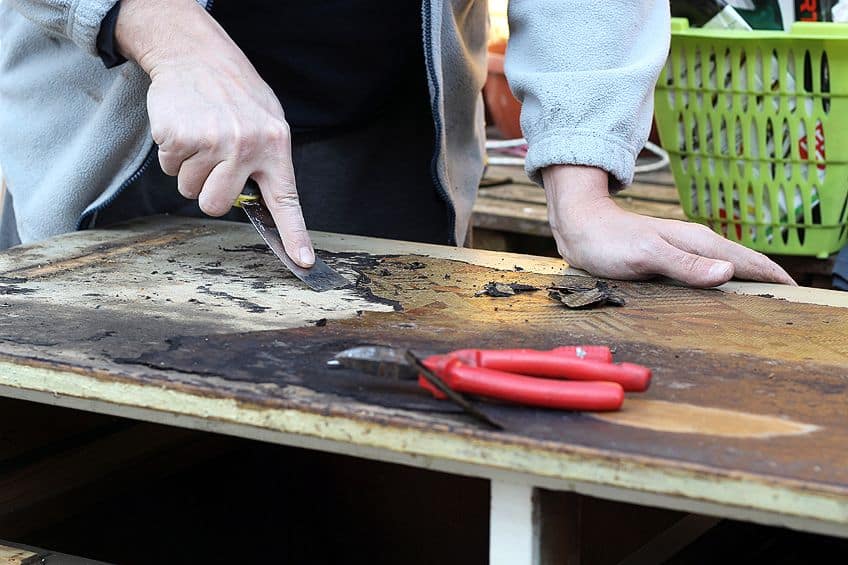
Frequently Asked Questions
Does Bleach Kill Mold?
You may be tempted to reach for bleach when attempting to kill mold on wood. It may be effective against surface mold, but this method will not penetrate porous surfaces such as wood, and thus does not kill the roots of the mold. Besides the toxic fumes, bleach can also discolor the surface of the wood, which is another reason as to why it is not recommended to kill mold on wood. There are natural chemicals available that are less toxic as well as more effective.
Should I Replace Wood That Has Mold on It?
Wood that has had mold on it might never need to be replaced as long as it is cleaned properly and it is kept dry. Outdoor wood needs to be sealed or treated to keep mold away. Wood needs to be replaced if the moisture content is excessive and if rot has set in.
How Can I Identify Toxic Mold?
Sadly, it is not possible to accurately identify toxic molds unless you are an expert. It is best to remove any and all mold from wood or other surfaces you might find before it spreads.
What Are the Symptoms of Toxic Mold Exposure?
Symptoms that are related to toxic mold exposure can range from irritated eyes and skin to coughing, tightness in the chest, and nasal congestion. Other symptoms include headaches, aches, and pains as well as nose bleeds.
When Should I Call a Mold Removal Professional?
Call a professional when the mold in an area of your home covers more than 10 square feet. Furthermore, consult a health professional if you think you have been exposed to toxic mold and are experiencing any symptoms.
Can Mold Cause Structural Damage?
Mold alone cannot cause structural damage. However, the conditions that mold thrives in are the same conditions that can attract decaying fungi that can destroy the structural integrity of the wood in your home.

I have been into woodworking since 2005 and woodturning since 2011. Because of my love for wood and woodworking, I started woodhappen.com to teach other enthusiasts about how to finish and seal wood, the best woodworking tools, the different types of wood, and everything else related to woodworking! Read more about me here.

